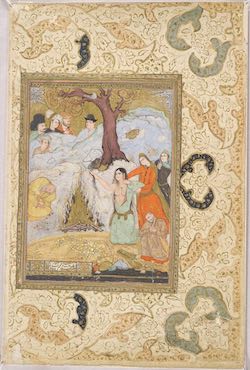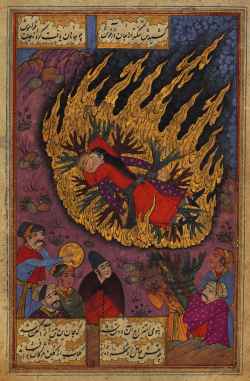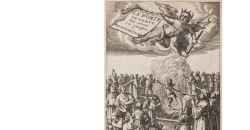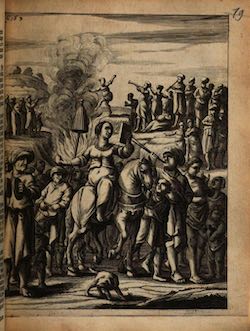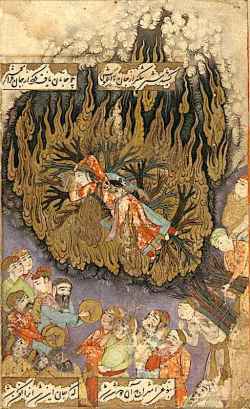A scene of Sati ritual Souryabha. Femme duchadja Jasingha se brulant. On represente icy la maniere en laquelle se brusla une femme de Radja Jasing appellée en la langue Indienne - Souryabha, qui veut dire lumiere du soleil, elle se brusla sans faire paroistre acucune crainte du feu ni de la mort.
Year: 1678-1686
From: Nicolo Manucci, Histoire de l'Inde depuis Tamerlank jusquà Orangzeb [ms Libro Rosso, fol. 50v]
Location: Bibliothèque nationale de France, Paris
External link: gallica.bnf.fr
Related Documents:
Satī (17th)
from: Manuscript, Iran
Harvard Art Museums/Arthur M. Sackler Museum, The Norma Jean Calderwood Collection of Islamic Art
Satī, from a Sūz u Gudāz manuscript. The union of the couple on the pyre (1657)
from: Sūz u Gudāz ms, Iran, Walters Manuscript W. 649, fol. 19b (Burning and Melting)
The Walters Art Museum, Baltimore, Maryland
Scene of a Sati, with a woman throwing herself into the flames amid a crowd playing trumpets. Above, a winged devil holds the banner with the book's title and the torch with which he lights the ritual fire. (1670)
from: Abraham Rogerius, Le Théâtre de l’idolatrie ou la porte ouverte, Amsterdam, Jean Schipper, 1670, title page
Scene of a sati. In the foreground, a widowed woman (encountered by Della Valle on November 12, 1623) on horseback holds a mirror and a lemon amidst a crowd. In the background, a woman throws herself into the flames of a funeral pyre (1665)
from: Della Valle, Pietro, De volkome beschryving der voortreffelijke reizen van de deurluchtige reisiger Pietro della Valle, edelman van Romen, in veel voorname gewesten des werrelts, sedert het jaer 1615, tot in 't jaar 1626 gedaan. Amsterdam, Abraham Wolfgang, 1666, vol. 5, pag. 163
Satī. The bride immolates herself on the funeral pyre (1657)
from: Isfahan, Iran
The Israel Museum, Jerusalem


